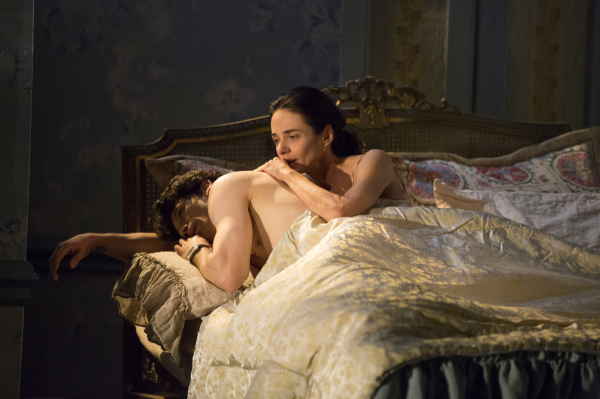Chéri

(© Joan Marcus)
Elegant movement, musicianship, and acting are all on display at the Signature Center in Martha Clarke’s daring adaptation of famed French author Colette’s 1920 novel Chéri and its 1926 sequel La Fin de Chéri. The production delves into these three artistic mediums with a small cast of four talented performers who take on Colette’s tragic love story. However, while ambition and artistry shine through, the whole picture that these converging mediums paint is ultimately less than the sum of its individually striking parts.
Clarke, as the production’s conceiver, director, and choreographer, has crafted a timeline of balletic vignettes, which trace the progression of a six-year affair between the young Chéri and his mother’s good friend, Léa — a woman nearly three decades his senior. Clarke has recruited some of the world’s top dancing talent to take on the sensual piece, with American Ballet Theatre principal dancer Herman Cornejo in the title role, alongside prima ballerina assoluta Alessandra Ferri as his mature lover. Though the two have garnered reputations as master technicians, both move across the stage with impressive abandon and fiery passion that offers a refreshingly modern twist on traditional ballet. Ferri’s skill as an actress shines throughout the piece, even in the midst of awe-inspiring feats of physical strength and grace from both dancers. Cornejo’s effortless lifts offer some of the most visually stunning moments, though his ease of execution makes it easy to take them for granted.
The story of Chéri, unfortunately, gets lost in this heated spectacle. Pianist Sarah Rothenberg beautifully accompanies the dancers with selections by contemporary French composers Ravel, Debussy, and Poulenc (as well as Spanish composer Mompou), gently settling us into 1912 France where we first meet the unlikely pair. This sultry 20th century music box in which we find ourselves, however, soon veers into lulling monotony. As each vignette jumps forward in time to a new point in the relationship between Chéri and Léa, the accompanying score stays at a constant tone, offering a timely atmosphere but doing little to accent or clarify the story. The choreography remains similarly stagnant throughout, even as Chéri and Léa grow older and undergo tumultuous transitions in their lives, both together and apart. While the passion that binds the two is abundantly clear, the push and pull that their age disparity creates — Léa’s personal struggle to come to terms with her own age, in particular — fails to clearly translate. The pair simply traverse set designer David Zinn’s minimalist suggestion of a Paris flat, engaging in acts of forbidden love. Vantage point admittedly plays a large role in how much of the story you are able to gather. A great deal of the piece’s most significant moments occur around a single mirror that leans against the back wall, and if you find yourself seated off in one of the theater’s corners, these moments will sadly pass by unnoticed.
The piece heavily relies on the narrative stylings of the ever-talented Amy Irving to fill in the plot that is not expressed through the choreography. Irving plays Chéri’s mother Charlotte (the production’s only speaking character) who comes onstage to deliver firsthand accounts of the events that have transpired since Chéri and Léa’s last meeting and offers context for the one that is to come. Irving does a fine job with Tina Howe’s effective text, balancing a narrative and conversational tone while painting an admirably full picture of her character despite the fact that her purpose, first and foremost, is efficiency. Yet, as she and the dancers alternately exchange places onstage, we can clearly see the seam that joins these two theatrical mediums. While all four performers demonstrate a fluid mastery of their individual crafts, they have yet to flow into a communal reservoir where each art form can build on the power that the others have to offer.










